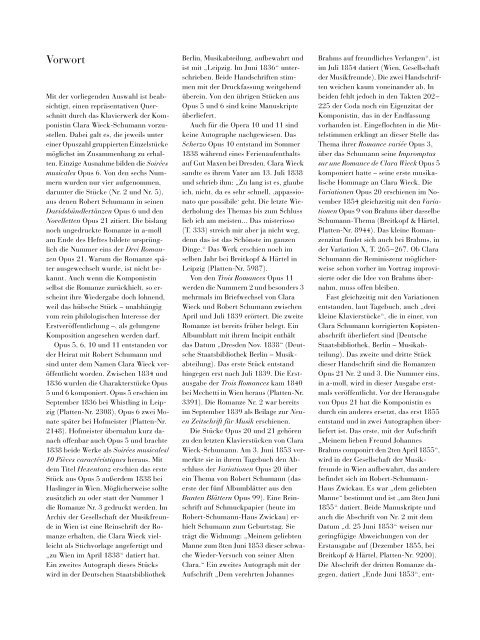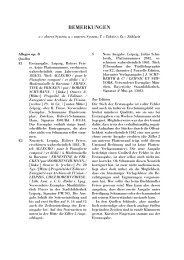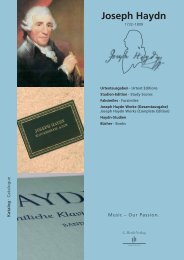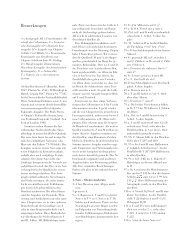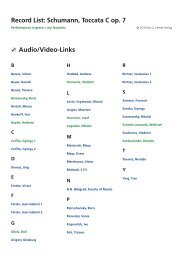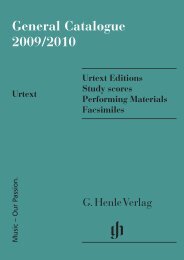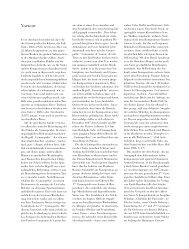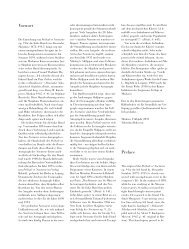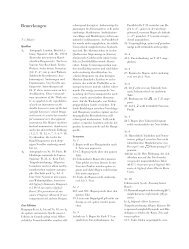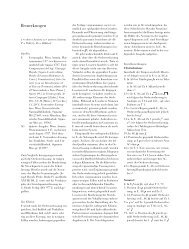Vorwort (PDF, 507 KB)
Vorwort (PDF, 507 KB)
Vorwort (PDF, 507 KB)
You also want an ePaper? Increase the reach of your titles
YUMPU automatically turns print PDFs into web optimized ePapers that Google loves.
IV<br />
<strong>Vorwort</strong><br />
Mit der vorliegenden Auswahl ist beabsichtigt,<br />
einen repräsentativen Querschnitt<br />
durch das Klavierwerk der Komponistin<br />
Clara Wieck-Schumann vorzustellen.<br />
Dabei galt es, die jeweils unter<br />
einer Opuszahl gruppierten Einzelstücke<br />
möglichst im Zusammenhang zu erhalten.<br />
Einzige Ausnahme bilden die Soirées<br />
musicales Opus 6. Von den sechs Nummern<br />
wurden nur vier aufgenommen,<br />
darunter die Stücke (Nr. 2 und Nr. 5),<br />
aus denen Robert Schumann in seinen<br />
Davidsbündlertänzen Opus 6 und den<br />
Novelletten Opus 21 zitiert. Die bislang<br />
noch ungedruckte Romanze in a-moll<br />
am Ende des Heftes bildete ursprünglich<br />
die Nummer eins der Drei Romanzen<br />
Opus 21. Warum die Romanze später<br />
ausgewechselt wurde, ist nicht bekannt.<br />
Auch wenn die Komponistin<br />
selbst die Romanze zurückhielt, so erscheint<br />
ihre Wiedergabe doch lohnend,<br />
weil das hübsche Stück – unabhängig<br />
vom rein philologischen Interesse der<br />
Erstveröffentlichung –, als gelungene<br />
Komposition angesehen werden darf.<br />
Opus 5, 6, 10 und 11 entstanden vor<br />
der Heirat mit Robert Schumann und<br />
sind unter dem Namen Clara Wieck veröffentlicht<br />
worden. Zwischen 1834 und<br />
1836 wurden die Charakterstücke Opus<br />
5 und 6 komponiert. Opus 5 erschien im<br />
September 1836 bei Whistling in Leipzig<br />
(Platten-Nr. 2308), Opus 6 zwei Monate<br />
später bei Hofmeister (Platten-Nr.<br />
2148). Hofmeister übernahm kurz danach<br />
offenbar auch Opus 5 und brachte<br />
1838 beide Werke als Soirées musicales/<br />
10 Pièces caractéristiques heraus. Mit<br />
dem Titel Hexentanz erschien das erste<br />
Stück aus Opus 5 außerdem 1838 bei<br />
Haslinger in Wien. Möglicherweise sollte<br />
zusätzlich zu oder statt der Nummer 1<br />
die Romanze Nr. 3 gedruckt werden. Im<br />
Archiv der Gesellschaft der Musikfreunde<br />
in Wien ist eine Reinschrift der Romanze<br />
erhalten, die Clara Wieck vielleicht<br />
als Stichvorlage angefertigt und<br />
„zu Wien im April 1838“ datiert hat.<br />
Ein zweites Autograph dieses Stücks<br />
wird in der Deutschen Staatsbibliothek<br />
Berlin, Musikabteilung, aufbewahrt und<br />
ist mit „Leipzig. Im Juni 1836“ unterschrieben.<br />
Beide Handschriften stimmen<br />
mit der Druckfassung weitgehend<br />
überein. Von den übrigen Stücken aus<br />
Opus 5 und 6 sind keine Manuskripte<br />
überliefert.<br />
Auch für die Opera 10 und 11 sind<br />
keine Autographe nachgewiesen. Das<br />
Scherzo Opus 10 entstand im Sommer<br />
1838 während eines Ferienaufenthalts<br />
auf Gut Maxen bei Dresden. Clara Wieck<br />
sandte es ihrem Vater am 13. Juli 1838<br />
und schrieb ihm: „Zu lang ist es, glaube<br />
ich, nicht, da es sehr schnell, ,appassionato<br />
que possibile‘ geht. Die letzte Wiederholung<br />
des Themas bis zum Schluss<br />
lieb ich am meisten... Das misterioso<br />
(T. 333) streich mir aber ja nicht weg,<br />
denn das ist das Schönste im ganzen<br />
Dinge.“ Das Werk erschien noch im<br />
selben Jahr bei Breitkopf & Härtel in<br />
Leipzig (Platten-Nr. 5987).<br />
Von den Trois Romances Opus 11<br />
werden die Nummern 2 und besonders 3<br />
mehrmals im Briefwechsel von Clara<br />
Wieck und Robert Schumann zwischen<br />
April und Juli 1839 erörtert. Die zweite<br />
Romanze ist bereits früher belegt. Ein<br />
Albumblatt mit ihrem Incipit enthält<br />
das Datum „Dresden Nov. 1838“ (Deutsche<br />
Staatsbibliothek Berlin – Musikabteilung).<br />
Das erste Stück entstand<br />
hingegen erst nach Juli 1839. Die Erstausgabe<br />
der Trois Romances kam 1840<br />
bei Mechetti in Wien heraus (Platten-Nr.<br />
3391). Die Romanze Nr. 2 war bereits<br />
im September 1839 als Beilage zur Neuen<br />
Zeitschrift für Musik erschienen.<br />
Die Stücke Opus 20 und 21 gehören<br />
zu den letzten Klavierstücken von Clara<br />
Wieck-Schumann. Am 3. Juni 1853 vermerkte<br />
sie in ihrem Tagebuch den Abschluss<br />
der Variationen Opus 20 über<br />
ein Thema von Robert Schumann (das<br />
erste der fünf Albumblätter aus den<br />
Bunten Blättern Opus 99). Eine Reinschrift<br />
auf Schmuckpapier (heute im<br />
Robert-Schumann-Haus Zwickau) erhielt<br />
Schumann zum Geburtstag. Sie<br />
trägt die Widmung: „Meinem geliebten<br />
Manne zum 8ten Juni 1853 dieser schwache<br />
Wieder-Versuch von seiner Alten<br />
Clara.“ Ein zweites Autograph mit der<br />
Aufschrift „Dem verehrten Johannes<br />
Brahms auf freundliches Verlangen“, ist<br />
im Juli 1854 datiert (Wien, Gesellschaft<br />
der Musikfreunde). Die zwei Handschriften<br />
weichen kaum voneinander ab. In<br />
beiden fehlt jedoch in den Takten 202–<br />
225 der Coda noch ein Eigenzitat der<br />
Komponistin, das in der Endfassung<br />
vorhanden ist. Eingeflochten in die Mittelstimmen<br />
erklingt an dieser Stelle das<br />
Thema ihrer Romance variée Opus 3,<br />
über das Schumann seine Impromptus<br />
sur une Romance de Clara Wieck Opus 5<br />
komponiert hatte – seine erste musikalische<br />
Hommage an Clara Wieck. Die<br />
Variationen Opus 20 erschienen im November<br />
1854 gleichzeitig mit den Variationen<br />
Opus 9 von Brahms über dasselbe<br />
Schumann-Thema (Breitkopf & Härtel,<br />
Platten-Nr. 8944). Das kleine Romanzenzitat<br />
findet sich auch bei Brahms, in<br />
der Variation X, T. 265–267. Ob Clara<br />
Schumann die Reminiszenz möglicherweise<br />
schon vorher im Vortrag improvisierte<br />
oder die Idee von Brahms übernahm,<br />
muss offen bleiben.<br />
Fast gleichzeitig mit den Variationen<br />
entstanden, laut Tagebuch, auch „drei<br />
kleine Klavierstücke“, die in einer, von<br />
Clara Schumann korrigierten Kopistenabschrift<br />
überliefert sind (Deutsche<br />
Staatsbibliothek, Berlin – Musikabteilung).<br />
Das zweite und dritte Stück<br />
dieser Handschrift sind die Romanzen<br />
Opus 21 Nr. 2 und 3. Die Nummer eins,<br />
in a-moll, wird in dieser Ausgabe erstmals<br />
veröffentlicht. Vor der Herausgabe<br />
von Opus 21 hat die Komponistin es<br />
durch ein anderes ersetzt, das erst 1855<br />
entstand und in zwei Autographen überliefert<br />
ist. Das erste, mit der Aufschrift<br />
„Meinem lieben Freund Johannes<br />
Brahms componirt den 2ten April 1855“,<br />
wird in der Gesellschaft der Musikfreunde<br />
in Wien aufbewahrt, das andere<br />
befindet sich im Robert-Schumann-<br />
Haus Zwickau. Es war „dem geliebten<br />
Manne“ bestimmt und ist „am 8ten Juni<br />
1855“ datiert. Beide Manuskripte und<br />
auch die Abschrift von Nr. 2 mit dem<br />
Datum „d. 25 Juni 1853“ weisen nur<br />
geringfügige Abweichungen von der<br />
Erstausgabe auf (Dezember 1855, bei<br />
Breitkopf & Härtel, Platten-Nr. 9200).<br />
Die Abschrift der dritten Romanze dagegen,<br />
datiert „Ende Juni 1853“, ent-
hält eine Version, deren Mittelteil sich<br />
noch stark vom Druck unterscheidet.<br />
Zwischen den Takten 124 und 137 der<br />
Endfassung erscheint hier ein motivisch<br />
verwandter, aber um 35 Takte längerer<br />
Abschnitt.<br />
Auch die Abschrift der a-moll Romanze<br />
mit dem Datum „d. 23 Juni 1853“<br />
weist zahlreiche Korrekturen auf. Sie<br />
kennzeichnen möglicherweise Stellen,<br />
die noch überarbeitet werden sollten,<br />
und sind keineswegs konsequent durchgeführt.<br />
Unsere Ausgabe gibt daher die<br />
frühere Fassung eines Autographs wieder,<br />
das Clara Schumann im Juli 1853<br />
für ihre Freundin Rosalie Leser angefertigt<br />
hat (Deutsche Staatsbibliothek, Berlin<br />
– Musikabteilung).<br />
Als Hauptquellen für die einzelnen<br />
Werke dienten jeweils die Erstausgaben.<br />
Alle übrigen genannten Quellen wurden<br />
zum Vergleich herangezogen. In den<br />
Bemerkungen am Ende des Bandes sind<br />
lediglich die wichtigsten Abweichungen<br />
zwischen den Quellen angeführt. Zeichen,<br />
die in der Hauptquelle fehlen,<br />
wurden in Klammern ergänzt. Aus den<br />
Nebenquellen wurden nur solche Zeichen<br />
(oder Versionen) ohne Klammern<br />
übernommen, die in der Hauptquelle<br />
durch Parallelstellen bestätigt sind oder<br />
musikalisch unbedingt notwendig erschienen.<br />
Kursive Fingersatzziffern<br />
stammen aus den Quellen. Die Hinweise<br />
auf die „richtige Anwendung des Pedals“<br />
in den originalen Fußnoten zu Opus 5<br />
und 6 gelten sicher auch für die übrigen<br />
Werke.<br />
Allen genannten Bibliotheken und<br />
Archiven, der Staatsbibliothek Preußischer<br />
Kulturbesitz Berlin, Musikabteilung,<br />
sowie Kurt Hofmann, Hamburg,<br />
sei herzlich dafür gedankt, dass sie so<br />
bereitwillig Quellenmaterial zur Verfügung<br />
gestellt haben. Ebenso danke ich<br />
Nancy B. Reich, Hastings on Hudson<br />
USA, und besonders Gerd Nauhaus,<br />
Zwickau, für den freundlichen Austausch<br />
von Informationen.<br />
Hamburg, Sommer 1986<br />
Janina Klassen<br />
Preface<br />
This collection is intended to present a<br />
representative cross-section of the piano<br />
compositions of Clara Wieck-Schumann.<br />
Separate pieces gathered under a single<br />
opus number have been kept in their<br />
original context. The only exception to<br />
this rule is the six Soirées musicales<br />
op. 6, of which only four have been included,<br />
among them nos. 2 and 5 which<br />
were quoted by Robert Schumann in his<br />
Davidsbündlertänze op. 6 and Novelletten<br />
op. 21. Originally, the first of the<br />
three Romanzen op. 21 was the previously<br />
unpublished Romance in a minor<br />
which appears at the end of this volume.<br />
It is not known why this Romance was<br />
later discarded. Even if the composer<br />
withheld this piece herself, it merits inclusion<br />
not only from purely historical<br />
considerations (this is its first appearance<br />
in print) but also as an attractive<br />
and successful composition in its own<br />
right.<br />
Opp. 5, 6, 10 and 11 were written before<br />
Clara’s marriage to Robert Schumann,<br />
and appeared under the name of<br />
Clara Wieck. The character pieces opp.<br />
5 and 6 were composed between 1834<br />
and 1836. Op. 5 was published in September<br />
1836 by Whistling in Leipzig<br />
(plate no. 2308), while op. 6 was issued<br />
two months later by Hofmeister (plate<br />
no. 2148). Shortly thereafter, Hofmeister<br />
apparently took over op. 5 as well, and<br />
issued both works in 1838 as Soirées<br />
musicales / 10 Pièces caractéristiques.<br />
The first piece of op. 5 also appeared<br />
under the title Hexentanz in 1838, the<br />
publisher being Haslinger in Vienna. The<br />
Romance no. 3 may have been intended<br />
for publication in addition to, or in place<br />
of, no. 1. The archives of the Gesellschaft<br />
der Musikfreunde in Vienna have<br />
a fair copy of the Romance in Clara’s<br />
hand with the date “zu Wien im April<br />
1838”, possibly intended as an engraver’s<br />
copy. A second autograph of this<br />
piece, dated “Leipzig. Im Juni 1836”, is<br />
preserved in the Deutsche Staatsbibliothek<br />
in Berlin – Musikabteilung. Both<br />
manuscripts are largely identical to the<br />
V<br />
printed version. No manuscript versions<br />
exist for the remaining pieces in opp. 5<br />
and 6.<br />
Nor do autograph versions exist for<br />
opp. 10 and 11. The Scherzo op. 10 was<br />
written in the summer of 1838 during a<br />
holiday at the Maxen estate near Dresden.<br />
On 13 July 1838 Clara Wieck sent<br />
it to her father with the remark (translated):<br />
“It is not too long, I believe, since<br />
it goes very fast ‘appassionato que possibile’.<br />
I like the final repetition of the<br />
theme to the end of the piece best of all...<br />
But don’t cut the misterioso (meas. 333)<br />
as this is the most beautiful part of the<br />
entire piece.” The work was published<br />
in that same year by Breitkopf & Härtel<br />
in Leipzig (plate no. 5987).<br />
Of the Trois Romances op. 11, no. 2<br />
and especially no. 3 were mentioned<br />
several times in Clara’s correspondence<br />
with Robert Schumann between April<br />
and July 1839. The second romance is<br />
proved at an earlier date. An album leaf<br />
bearing its incipit is dated “Dresden<br />
Nov. 1838” (Deutsche Staatsbibliothek,<br />
Berlin – Musikabteilung). The first<br />
piece, on the other hand, was not written<br />
until after July 1839. The first edition<br />
of the Trois Romances was issued<br />
in 1840 by Mechetti in Vienna (plate<br />
no. 3391). By then no. 2 had already<br />
appeared in September 1839 as a supplement<br />
to the Neue Zeitschrift für<br />
Musik.<br />
Opp. 20 and 21 are among Clara<br />
Wieck-Schumann’s last pieces for the<br />
piano. On 3 June 1853, she noted in her<br />
diary that she had completed the variations<br />
op. 20 on a theme by Robert Schumann<br />
(the first of the five album leaves<br />
from Bunte Blätter op. 99). A fair copy<br />
on ornamental paper (now in the Robert-<br />
Schumann-Haus in Zwickau) was given<br />
to Schumann on his birthday. It bears<br />
the dedication (translated): “To my beloved<br />
husband on the 8th of June 1853<br />
this humble, renewed essay by his old<br />
Clara.” A second autograph, with the<br />
heading “To the esteemed Johannes<br />
Brahms at his kind request”, is dated<br />
July 1854 (Gesellschaft der Musikfreunde<br />
in Vienna). These two manuscripts<br />
seldom deviate from each other. However,<br />
neither contains a self-quotation on
VI<br />
the part of the composer which appears<br />
in measures 202 to 225 of the coda in<br />
the final version. This passage contains,<br />
woven into the inner parts, the theme of<br />
her Romance variée op. 3 which Schumann<br />
used for his Impromptus sur une<br />
Romance de Clara Wieck op. 5 – his first<br />
musical homage to Clara. The variations<br />
op. 20 appeared in November 1854 at<br />
the same time as Johannes Brahms’s<br />
variations op. 9 on the same Schumann<br />
theme (Breitkopf & Härtel, plate no.<br />
8944). Brahms likewise briefly quoted<br />
the Romance theme, in measures 265 to<br />
267 of variation no. X. It is uncertain<br />
whether Clara Schumann had previously<br />
improvised this reminiscence or took<br />
the idea from Brahms.<br />
Almost at the same time as the variations,<br />
Clara also composed, according<br />
to her diary, “three little piano pieces”<br />
which have survived in a copyist’s manuscript<br />
with Clara’s corrections (Deutsche<br />
Staatsbibliothek, Berlin – Musikabteilung).<br />
The second and third pieces<br />
in this manuscript are the Romances<br />
op. 21, no. 2 and no. 3. The first piece,<br />
in a minor, is published for the first time<br />
in this edition. Before having op. 21<br />
published, the composer replaced this<br />
piece with another, not written until<br />
1855, which has survived in two autographs.<br />
The first bears the remark “Written<br />
for my dear friend Johannes Brahms<br />
on the 2nd of April, 1855”, and is preserved<br />
in the Gesellschaft der Musikfreunde<br />
in Vienna. The other, located at<br />
the Robert-Schumann-Haus in Zwickau,<br />
was intended for her “beloved husband”<br />
and is dated “am 8ten Juni 1855”.<br />
Both manuscripts, as well as the copy of<br />
no. 2 with the date “d. 25 Juni 1853”,<br />
reveal only minor deviations from the<br />
first edition of December 1855 (Breitkopf<br />
& Härtel, plate no. 9200). In contrast,<br />
the copy of the third Romance, dated<br />
“Ende Juni 1853”, contains a version<br />
whose middle section differs greatly<br />
from the print, including, between<br />
measures 124 and 137 of the final version,<br />
a motivically related section with<br />
35 additional measures.<br />
The copy of the a minor Romance,<br />
dated “d. 23 Juni 1853”, also reveals<br />
numerous corrections. They may refer<br />
to passages which were to be revised at a<br />
later date, and are by no means consistently<br />
carried out. Our edition therefore<br />
gives the earlier version of an autograph<br />
which Clara Schumann wrote out in July<br />
1853 for her friend Rosalie Leser (Deutsche<br />
Staatsbibliothek, Berlin – Musikabteilung).<br />
The pieces in this edition are based<br />
primarily on the respective first editions.<br />
All other sources named have been consulted<br />
for purposes of comparison. The<br />
Comments at the end of this volume<br />
merely indicate where major deviations<br />
occur among the sources. Signs omitted<br />
in the principal source have been added<br />
in parentheses. Signs (or versions) have<br />
been adopted from the secondary sources<br />
without parentheses only if they are<br />
confirmed by parallel passages in the<br />
principal source or seemed absolutely<br />
essential for musical reasons. Fingering<br />
in italics is taken from the sources. The<br />
annotations in the original footnotes to<br />
opp. 5 and 6 regarding “proper use of<br />
the pedal” most likely apply to the other<br />
pieces as well.<br />
The editor wishes to extend her thanks<br />
to all the above-named libraries and archives<br />
as well as the Staatsbibliothek<br />
Preußischer Kulturbesitz Berlin, Musikabteilung<br />
and Kurt Hofmann in Hamburg<br />
for willingly granting access to<br />
source material. Thanks are also due to<br />
Nancy B. Reich, Hastings on Hudson<br />
U.S.A., and in particular to Gerd Nauhaus,<br />
Zwickau, for kindly providing information.<br />
Hamburg, summer 1986<br />
Janina Klassen<br />
Préface<br />
Le présent volume a pour objectif de<br />
donner un aperçu représentatif des<br />
œuvres pour piano de Clara Wieck-<br />
Schumann. L’un des principes direc-<br />
teurs quant au choix des compositions<br />
a été de conserver si possible ensemble<br />
les morceaux regroupés sous un même<br />
numéro d’opus. Les Soirées musicales,<br />
opus 6 constituent la seule exception<br />
à cet égard. Sur les six pièces en effet,<br />
quatre seulement ont été retenues, dont<br />
les N os 2 et 5 sont cités par Robert Schumann<br />
dans ses Davidsbündlertänze, op.<br />
6 et ses Novellettes, op. 21. La Romance<br />
en la mineur, éditée ici pour la première<br />
fois et qui se trouve à la fin du recueil,<br />
constituait à l’origine le numéro 1 des<br />
trois Romances, opus 21. On ignore pourquoi<br />
cette Romance a été remplacée ultérieurement.<br />
Toutefois, malgré le fait<br />
que la compositrice elle-même ait retiré<br />
cette pièce, il semble qu’il vaille la peine<br />
de la restituer ici étant donné que ce joli<br />
morceau peut être – indépendamment de<br />
l’intérêt purement philologique que présente<br />
cette première publication – considéré<br />
comme une composition réussie.<br />
Les opus 5, 6, 10 et 11 datent d’avant<br />
le mariage de Clara avec Robert Schumann<br />
et furent publiés sous le nom de<br />
Clara Wieck. Les pièces de caractère,<br />
opus 5 et 6 furent composées entre 1834<br />
et 1836. L’opus 5 parut en septembre<br />
1836 chez Whistling, à Leipzig (cotage<br />
2308) et l’opus 6 deux mois plus tard<br />
chez Hofmeister (cotage 2148). Hofmeister<br />
reprit peu après aussi à son<br />
compte l’opus 5 et publia en 1838 les<br />
deux œuvres sous le titre de Soirées musicales<br />
/ 10 Pièces caractéristiques.<br />
La première pièce de l’opus 5 parut en<br />
outre en 1838, chez Haslinger, à Vienne,<br />
sous le titre de Hexentanz. Il se peut<br />
qu’il ait été prévu initialement de publier<br />
la Romance N o 3 en plus ou à la<br />
place du N o 1. Les archives de la Gesellschaft<br />
der Musikfreunde de Vienne renferment<br />
une copie au propre de la Romance,<br />
peut-être réalisée par Clara Wieck<br />
comme modèle de gravure, et datée «zu<br />
Wien im April 1838». Un deuxième autographe<br />
de cette pièce se trouve à la<br />
Deutsche Staatsbibliothek Berlin – Musikabteilung,<br />
et il est signé «Leipzig. Im<br />
Juni 1836». Les deux autographes concordent<br />
dans une large mesure avec la<br />
version imprimée. Aucun manuscrit ne<br />
subsiste des autres pièces des opus 5 et 6.
On ne connaît pas non plus d’autographes<br />
pour les opus 10 et 11. Le Scherzo,<br />
op. 10 fut écrit pendant l’été 1838,<br />
au cours de vacances à la propriété<br />
Maxen, près de Dresde. Clara Wieck<br />
l’envoya à son père le 13 juillet 1838,<br />
accompagné d’une lettre où elle écrivait<br />
(traduit): «Je ne crois pas qu’il soit trop<br />
long, étant donné que cela se joue très<br />
vite, ‹appassionato que possibile›. C’est<br />
la dernière reprise du thème jusqu’à la<br />
fin qui me plaît le mieux... Mais ne me<br />
supprime surtout pas le misterioso (mes.<br />
333), car c’est le plus beau de l’ensemble.»<br />
L’œuvre parut la même année, chez<br />
Breitkopf & Härtel, à Leipzig (cotage<br />
5987).<br />
En ce qui concerne les Trois Romances,<br />
opus 11, les N os 2 et 3 ont été commentés<br />
à plusieurs reprises par Clara<br />
Wieck et Robert Schumann dans leur<br />
correspondance, entre avril et juillet<br />
1839. La deuxième Romance remonte<br />
déjà à une date antérieure. Une page<br />
d’album avec incipit porte la date «Dresden<br />
Nov. 1838» (Deutsche Staatsbibliothek<br />
Berlin – Musikabteilung). Le premier<br />
morceau par contre ne fut composé<br />
qu’après juillet 1839. La première édition<br />
des Trois Romances fut publiée en<br />
1840 chez Mechetti, à Vienne (cotage<br />
3391). La Romance N o 2 était déjà parue<br />
en septembre 1839 en annexe à la<br />
Neue Zeitschrift für Musik.<br />
Les opus 20 et 21 comptent parmi les<br />
dernières compositions pour piano de<br />
Clara Wieck-Schumann. Le 3 juin 1853,<br />
elle nota dans son journal la fin des Variations,<br />
op. 20 sur un thème de Robert<br />
Schumann (la première des cinq pages<br />
d’album tirées des Bunte Blätter, opus<br />
99). Schumann reçut pour son anniversaire<br />
une copie autographe au propre sur<br />
papier décoré (conservée aujourd’hui à<br />
la Robert-Schumann-Haus, à Zwickau),<br />
avec la dédicace (traduite): «A mon<br />
époux bien aimé, pour le 8 juin 1853, ce<br />
nouvel essai, bien pauvre, de sa vieille<br />
Clara.» Un deuxième autographe portant<br />
l’inscription (traduite) «Au très estimé<br />
Johannes Brahms, sur son amicale<br />
demande» est daté de juillet 1854 (Gesellschaft<br />
der Musikfreunde de Vienne).<br />
Les deux autographes ne diffèrent guère<br />
l’un de l’autre. Dans les deux cepen-<br />
dant, il manque aux mesures 202–225<br />
de la coda une citation propre de la<br />
compositrice, citation reprise plus tard<br />
dans la version définitive. Entremêlé<br />
aux parties médianes retentit à cet<br />
endroit le thème de la Romance variée,<br />
opus 3 de Clara, sur lequel Robert Schumann<br />
avait composé ses Impromptus<br />
sur une Romance de Clara Wieck op. 5,<br />
son premier hommage musical à Clara<br />
Wieck. Les Variations, opus 20 parurent<br />
en novembre 1854 en même temps<br />
que les Variations, opus 9 de Brahms<br />
sur le même thème de Schumann (Breitkopf<br />
& Härtel, cotage 8944). La petite<br />
citation de la Romance de Clara se retrouve<br />
aussi chez Brahms, dans la Variation<br />
X, mes. 265–267. Il n’est pas<br />
possible de savoir si Clara Schumann<br />
avait éventuellement déjà improvisé<br />
cette réminiscence lors de ses récitals<br />
ou si elle reprit l’idée de Brahms.<br />
Comme il ressort du journal, «trois<br />
petits morceaux pour piano» furent<br />
composés par Clara Schumann presque<br />
en même temps que les variations; ils<br />
nous sont parvenus sous la forme d’un<br />
manuscrit d’un copiste corrigé par Clara<br />
Schumann (Deutsche Staatsbibliothek<br />
Berlin – Musikabteilung). Les deuxième<br />
et troisième morceaux de ce manuscrit<br />
sont les Romances, opus 21, N os 2 et 3.<br />
Le N o 1, en la mineur, est publié pour la<br />
première fois dans cette édition. Avant<br />
la publication de l’opus 21, la compositrice<br />
l’avait remplacé par un autre, composé<br />
en 1855 seulement et dont deux<br />
autographes ont été conservés. Le premier,<br />
portant la mention «A mon cher<br />
ami Johannes Brahms, composé le 2<br />
avril 1855» se trouve dans les archives<br />
de la Gesellschaft der Musikfreunde, à<br />
Vienne, et le second à la Robert-Schumann-Haus,<br />
à Zwickau; ce dernier était<br />
destiné à «l’époux bien-aimé» et daté<br />
«am 8ten Juni 1855». Les deux manuscrits<br />
et la copie du N o 2 portant la date<br />
«d. 25 Juni 1853» ne présentent que des<br />
divergences minimes avec la première<br />
édition (décembre 1855, chez Breitkopf<br />
& Härtel, cotage 9200). La copie de la<br />
troisième Romance par contre, datée de<br />
«Ende Juni 1853», offre une version<br />
dont la partie centrale se distingue encore<br />
fortement de l’édition. Entre les me-<br />
VII<br />
sures 124 et 137 de la version définitive<br />
s’interpose un passage apparenté quant<br />
aux motifs mais comprenant 35 mesures<br />
de plus.<br />
La copie de la Romance en la mineur,<br />
datée «d. 23 Juni 1853», présente aussi<br />
de nombreuses corrections. Elles correspondent<br />
le cas échéant à des passages à<br />
revoir et ne sont nullement effectuées de<br />
façon conséquente. Notre édition reprend<br />
donc la version antérieure d’un autographe<br />
que Clara Schumann avait réalisé<br />
en juillet 1853 pour son amie Rosalie<br />
Leser (Deutsche Staatsbibliothek Berlin<br />
– Musikabteilung).<br />
Les premières éditions ont toujours<br />
été retenues comme sources principales<br />
pour les différentes œuvres et les autres<br />
sources citées ont été consultées aux fins<br />
de comparaison. Dans les Remarques à<br />
la fin du volume, seules les principales<br />
divergences entre les sources sont mentionnées.<br />
Les signes faisant défaut dans<br />
les sources principales ont été rajoutés<br />
entre parenthèses. Les signes (ou versions)<br />
des sources secondaires n’ont été<br />
directement repris, sans parenthèses,<br />
que s’ils se trouvaient confirmés dans<br />
la source principale par des passages<br />
parallèles ou s’ils apparaissaient absolument<br />
nécessaires sur le plan musical.<br />
Les doigtés en italique proviennent des<br />
sources. Les indications relatives à «l’emploi<br />
correct de la pédale» dans les notes<br />
en bas de page originales des opus 5 et 6<br />
sont certainement valables aussi pour<br />
les autres œuvres.<br />
Nous remercions chaleureusement les<br />
bibliothèques et archives mentionnées,<br />
la Staatsbibliothek Preußischer Kulturbesitz<br />
Berlin, Musikabteilung, ainsi que<br />
M. Kurt Hofmann, de Hamburg, pour<br />
les sources et la documentation aimablement<br />
mises à notre disposition. Je remercie<br />
également Nancy B. Reich, d’Hastings<br />
on Hudson U.S.A., et tout particulièrement<br />
Gerd Nauhaus, de Zwickau,<br />
pour les informations qu’ils nous ont<br />
aimablement fournies.<br />
Hambourg, été 1986<br />
Janina Klassen


